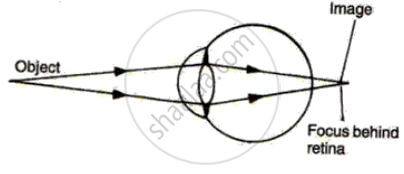Advertisements
Advertisements
प्रश्न
Write an Explanation.
Farthest distance of distinct vision
उत्तर
The farthest distance of an object from a normal human eye, at which it is clearly visible without stress on the eye is called as farthest distance of distinct vision.
APPEARS IN
संबंधित प्रश्न
List the parts of the human eye that control the amount of light entering into it. Explain how they perform this function.
Write the function of the following part of the human eye: crystalline lens
The optical prescription for a pair of spectacles is :
Right eye : −3.50 D
Left eye : −4.00 D
Which lens has a greater focal length?
Name the part of the eye:
which controls the amount of light entering the eye.
What happens to the eye when you enter a darkened cinema hall from bright sunshine? Give reason for your answer.
There are two types of light-sensitive cells in the human eye:
What is each type called?
There are two types of light-sensitive cells in the human eye:
To what is each type of cell sensitive?
List, in order, the parts of the eye through which light passes to reach the retina.
What happens to the size of pupil of our eye (i) in dim light (ii) in bright light?
Explain why, we cannot see our seats first when we enter a darkened cinema hall from bright light but gradually they become visible.
The size of the pupil of the eye is adjusted by:
(a) cornea
(b) ciliary muscles
(c) optic nerve
(d) iris
Which parts of the eye cause rays of light to converge on the retina?
A person got his eyes tested. The optician's prescription for the spectacles reads:
Left eye: − 3.00 D
Right eye: − 3.50 D
The person is having a defect of vision called:
(a) presbyopia
(b) myopia
(c) astigmatism
(d) hypermetropia
Five persons A, B, C, D and E have diabetes, leukaemia, asthma, meningitis and hepatitis, respectively.
Which of these persons cannot donate eyes?
The animals called predators have:
(a) both the eyes on the sides
(b) one eye on the side and one at the front
(c) one eye on the front and one at the back
(d) both the eyes at the front
With reference to the functioning of the eye, answer the question that follow:
Name the two structure in the eye responsible for bringing about the change in the shape of the lens.
State the function of each of the following parts of the human eye:
(i) Cornea
(ii) Iris
(iii) Pupil
(iv) Retina
Millions of people of the developing countries are suffering from corneal blindness. This disease can be cured by replacing the defective cornea with the cornea of a donated eye. Your school has organised a campaign in the school and its neighbourhood in order to create awareness about this fact and motivate people to donate their eyes after death. How can you along with your classmates contribute in this noble cause? State the objectives of organising such campaigns in schools.
Define the following:
Blind spot
The diagram alongside represents a certain defect of vision of the human eye.
(i) Name the defect.
(ii) Describe briefly the condition in the eye responsible for the defect.
(iii) Redraw the figure by adding a suitable lens correcting the defect. Label the parts through which light-rays pass.
(iv) What special advantage do human beings derive in having both eyes facing forward?

What are the functions of tears?
What is meant by power of accommodation of the eye?
What is a stereoscopic vision?
Draw a diagram of the human eye as seen in a vertical section and label the parts which suit the following descriptions relating to the:
(i) photosensitive layer of the eye.
(ii) structure which is responsible for holding the eye lens in its position.
(iii) structure which maintains the shape of the eyeball and the area of no vision.
(iv) anterior chamber seen in front of the eye lens.
(v) outermost transparent layer seen in front of the eyeball.
Name the following:
The most sensitive region of the retina.
Name the following:
The innermost layer of the eye
Name the following:
The type of lens used for correcting myopia.
A small hole of changing diameter at the centre of Iris is called _______.
The larynx has fold of tissue which vibrate with the passage of air to produce sound.
Explain the structure and functioning of Human eye. How are we able to see nearby as well as distant objects?
Write down the names of parts of the eye in the blank spaces shown in the figure.

The change in the focal length of an eye lens in human beings is caused by the action of ______.
Match the following:
| Column - I | Column - II | ||
| 1 |
Retina |
a | Pathway of light |
| 2 | Pupil | b |
Far point comes closer |
| 3 | Ciliary muscles | c |
near point moves away |
| 4 | Myopia | d | Screen of the eye |
| 5 | Hypermetropia | f | Power of accommodation |
With reference to human eye, answer the following question.
What is aqueous humor?
State the functions of the following:
Ciliary muscles
An aperture that controls the passage of light into the eye is ______.
